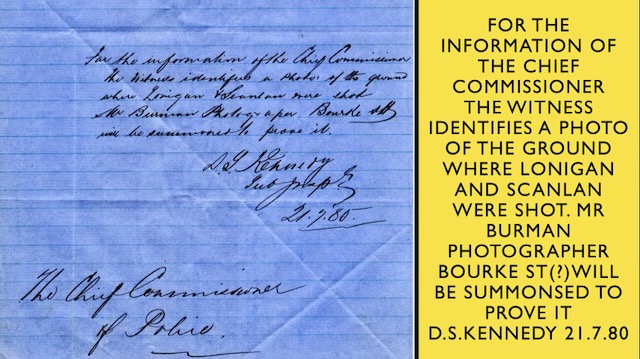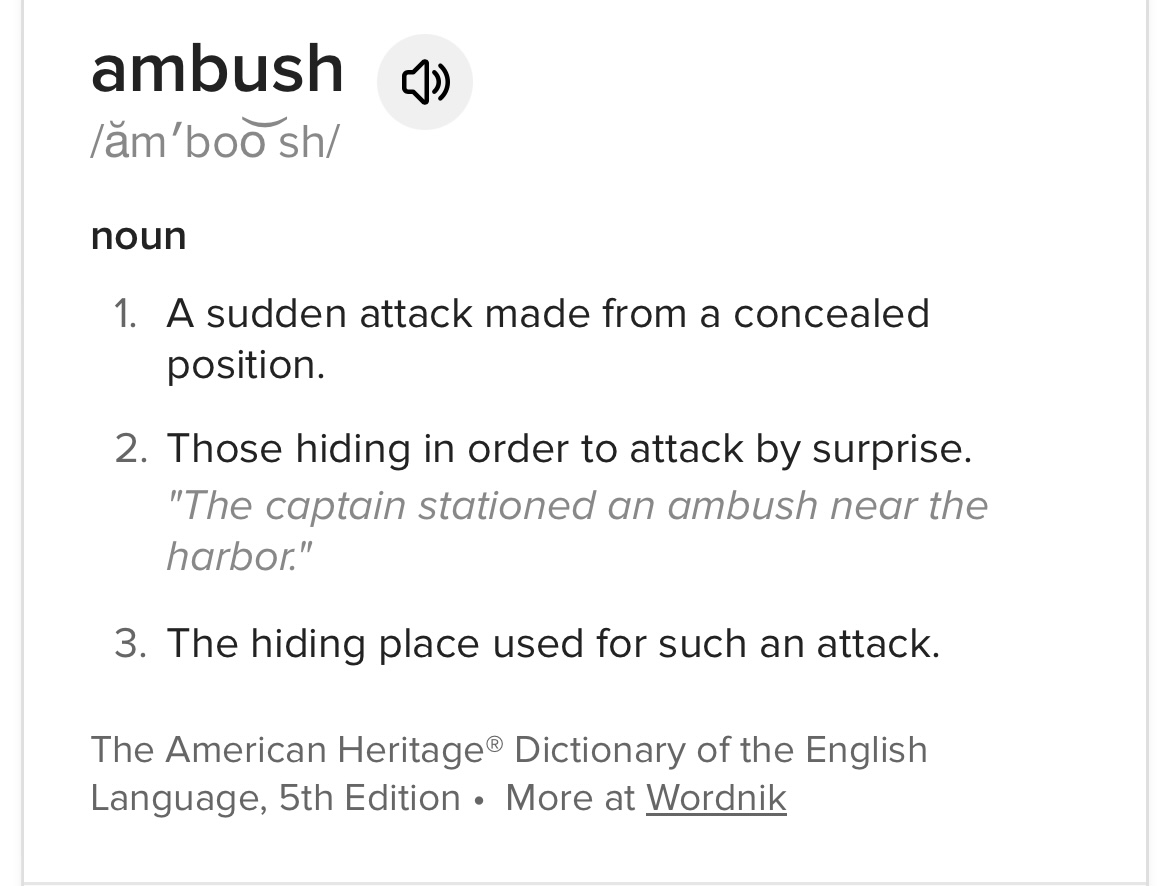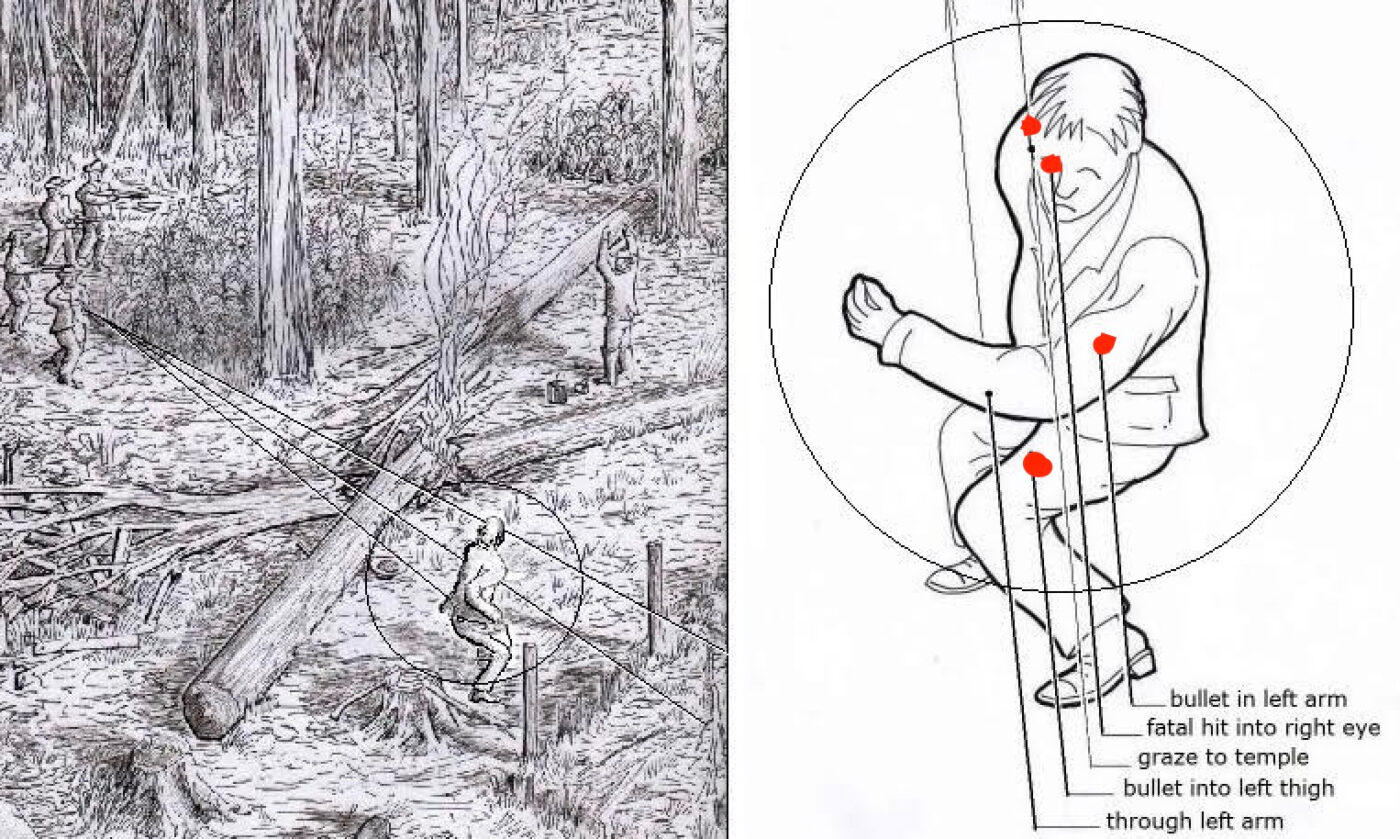According to Bill “Ned was dudded big time by Thomas McIntyre and the court, and by that trick Ned Kelly was not able to claim self-defence, and he was sentenced to death by hanging with the express purpose to show the lower classes of society that they should not meddle with the conservative controlling elite”. (P 303)
There are so many elements of that sentence that are just plain wrong. For one thing, Ned Kelly WAS able to claim self-defence if he had wanted to but he and his team chose NOT to. It was entirely up to them to make whatever arguments in Kellys defence that they wanted to, and the only possible explanation for their decision not to use self-defence as a defence has to be that they didn’t believe such a claim would have succeeded. You would have to be insane to use a defence strategy that had no hope of succeeding or, on the other hand to not use a defence strategy you believed would! It is an important and widely believed misconception about Kellys trial that needs to be corrected: if Kelly and his team had wanted to claim self-defence as the basis for the police murders, they were entitled to do so and there was no reason for them not to. To not use that defence was entirely up to them.
Secondly, it is a gross misrepresentation for Bill to suggest that all Ned Kelly did was “meddle with the conservative controlling elite” and that the “express purpose” of his hanging was to teach the lower classes a lesson about who controls who. The reality is that the Court didn’t find that Kelly “meddled” with Lonigan – the Court found that he committed a most heinous crime, the murder of Thomas Lonigan in cold blood: a young man doing his duty, a young man with children and a young wife, now a widow who relied on him. The express purpose of Kellys punishment was to teach a lesson to everyone, that you don’t go around murdering people.
But those issues are not the core of Bills argument about why he says McIntyre dudded Ned Kelly.
Bills main contention about McIntyre is not easy to follow because of the typically convoluted and round-about way that is Bills style, and I would be surprised if any sympathiser anywhere even tried to follow it, let alone understood or was able to provide a critique of it. What Bill believes is that the famous Burman photos of the police campsite were vital pieces of evidence for the defence, but they were corruptly misrepresented by McIntyre, and so were not able to be used in evidence: “(They) would have provided visual evidence to support Kellys claim that he and his companions were not the aggressors in the confrontation with police”(p 292).Thus, by having them declared inadmissible, Bill says, McIntyres “manipuation of the facts ultimately outsmarted Ned, leaving him dudded. (Note : to be dudded is an Aussie term where the clever trickster outsmarts the unsuspected)”

To make his point Bill explains in his usual meticulous way how we can be sure that the Burman photo is a view looking south across the police campsite. That much of his argument is sound. The photo is therefore also an image of the terrain to the south of the camp, across which the gang strode when they entered the camp. According to Bill the photographic evidence supports the idea that the murders were committed in self-defence because the Gangs approach from the south couldn’t have been an ambush or an attack from cover, because it was relatively open ground.
However, his much more contentious view, expressed in Chapter 12, is that the Kellys entered the police camp from the south in a way that wasn’t threatening – “they simply approached and walked into the strangers camp demanding them to bail up” (p292), and that they “did not initiate any shooting at the police camp, and that they only acted in self-defence once a gun was drawn” (p297). Bill seems to believe the police over-reacted, started shooting and the Kellys then had to shoot back in self-defence. He is wrong to suggest the gang believed they were confronting unknown ‘strangers’ – Ned Kelly himself made it clear in the Jerilderie letter that the Gang knew very well that the four men they were about to confront were police. Kelly wrote that he needed to beat this group of police before they were joined by the second party of police coming from the north or else “our doom was sealed”. In the Jerilderie letter Kelly described how they crept as close to them as they could and watched them for some time before confronting them with guns drawn.
McIntyre’s testimony paints a very different picture, one that is incompatible with Kellys claim that the killings were acts of self-defence; according to McIntyre, without warning he and Lonigan were surprised by four armed men advancing rapidly toward them, shouting at them to ‘bail up’ and within seconds, and before Lonigan had time to draw his weapon let alone fire it, he was shot and killed. So, whose version is to be believed?
Bill believes the Burman photos prove it was McIntyre’s account that was wrong, and his theory, which is effectively a conspiracy theory, is that the prosecution and McIntyre successfully conspired to protect his false account of the encounter, by having the photos excluded as evidence. What McIntyre did that was corrupt, according to Bill, was to claim that the photos were taken from the “south west corner of the campsite” looking to the north, and so didn’t show the place that the Gang approached the camp from. The evidence of the photos was thereby rendered useless. However, elsewhere, McIntyre said that the photos showed the ground on the north side of the logs where Lonigan and Scanlan were murdered – and it would only possible to show the ground on the north side of the logs if the photos were taken from the northeast corner of the site. McIntyre clearly knew what the photos showed…so Bills question is why did he then say they were taken from the south west? Answer: to discredit the photographic evidence that showed Kelly couldn’t have ambushed the police as McIntyre claimed, and thereby make sure he was convicted of murder. Dudded.
The only problem for Bills theory is that there’s a huge and fatal hole in it : McIntyre never claimed that the images were taken from the south west corner! Bills argument relies on Keith McMenomys 2001 book “The Authentic Illustrated History” but the reference for that claim doesn’t lead to a document where McIntyre said the photos were taken from the southwest. A prolonged and exhaustive search for it last year by several contributors to a discussion on this Blog about the Burman photos (Read it HERE ) found nothing. Instead what was found were very clear sworn statements by McIntyre that what was shown in the photos was the ground on the north side of the logs, the place where Lonigan and Scanlan were murdered. That can only mean McIntyre correctly believed Burman’s images were taken looking to the south and that they showed the place where the gang entered the campsite. There is no record of him saying anything different.
Furthermore, Bills claim that Kelly wanted to introduce the Burman photos as part of a self-defence argument is not supported by any documentation I know of. I would be happy to be proved wrong but there is very little discussion about the Burman photos in the records of the time, and I think it’s really just a theory that Bill has developed and become convinced by. If anyone has evidence to the contrary I would be happy to see it.
The reality is that if Kelly and his team wanted to advance a self-defence argument they were perfectly free to go ahead and do it. Nobody had any legal right to stop them from mounting a defence on whatever grounds they wanted to. If they wanted to introduce the Burman photos as evidence they were entitled to, and if they wanted to they could have then challenged the prosecutors’ doubts about them, and cross examined McIntyre about his opinion of what they showed to make the case that Bill thinks they should have, that the photos supported the self-defence justification for the killings. They could even have called Burman if they wanted to. But they didn’t do any of that, and they never mounted the case for self-defence – and the only rational reason for choosing not to can only be that they didn’t think it would succeed.
McIntyre was in fact an honourable man who was not a liar or a perjuror as Ian Jones used to so disgracefully claim. His testimony was unwavering : Ned Kelly shot and killed Lonigan within seconds of confronting him, the Jury at his trial believed him and rightly determined it was murder and Kelly was punished according to the laws of the day. He wasn’t dudded by McIntyre. He was brought to account.

Hi David and Bill, it looks to me like the discussion of the direction the Burman photos were taken from is not very relevant to the question of a self defence argument. First, they are acted approximate reconstructions, not forensically accurate reconstructions. The argument about their direction seems to be an argument between Bill and the CSI@SBC group, but assuming Bill is right, the photos still don’t prove anything about the gang’s advance because he seems to accept that the gang advanced from the south. McIntyre’s testimony and sketch maps agree with that; the gang advanced from the south.
Second, the gang advanced rapidly from behind a stand of spear grass. Whether or not Bill accepts that the spear grass was there or not is due to arguments about the direction the photos were taken from, the fact remains that one of the published sketches of the location shows the spear grass. It is also marked on McIntyre’s map.
The main issue seems to be something else; that Bill Is arguing that the police were not ambushed because they were not lying in wait for the police but simply walked into their campsite in plain view and then demanded their surrender. Following on from that he seems to be saying that this means that Kelly actually fired in self defence when Lonigan went for his revolver. Let’s see if we can clarify that first.
BTW, I have nearly finished a review of the sections of Bill’s book that were a critique of my Republic Myth book, but it will take a few more days to finish off.
Bill actually says that Lonigan didnt just go for his revolver, he got it out and was about to use it. What Ned Kelly claimed was that Lonigan ran back to a ‘battery’ of logs, hid behind them and the lifted his head and his revolver up from behind them, and was about to fire when Kelly got in first and shot him in the head.
This scenario is of course very different from the account McIntyre gave – his account was that within a few seconds of the order to Bail Up Kelly shifted his rifle off McIntyre to Lonigan and shot him. Lonigan had no time to even unbutton his revolver let alone remove it from the holster and aim it.
The reason we know that Kellys version is false is that Lonigan had a bullet wound in his left thigh, a place that would have been protected by the battery of logs if he had been behind it. Its very clear from the pattern of the wounds, which were all inflicted when he was alive according to Dr Samuel Reynolds, that Lonigan was out in the open and had barely enough time to take a couple of steps before he was shot.
Kellys version is yet another of his self serving lies.
hi David, I agree with you on all that, but what I am trying to clarify is what seems to be two claims, first, that it was not an ambush because the gang were not lying in wait, which is of course only one definition of ambush but it is insisted on at least three times. This is relevant because Bill is challenging my Republic Myth book statement that it was an ambush.
Second, the argument seems to be along the lines that Kelly actually fired in self defence when Lonigan went for his revolver. The same idea would apply if Lonigan drew his revolver, and also if he actually fired it; but I am putting the extreme case of a self defence argument being legitimised simply by the fact of Lonigan having an intention to shoot regardless whether he had got his pistol out. I have seen other writers go that far, so I want to test how far that self defence line of argument can go. It’s an experiment rather than an argument with Bill. Other people might have views on it too?
Hi again Stuart,
sadly very few of he people who claim to be interested in the Kelly story are willing or capable of discussing things like this. They have their dogmas , and thats it as far as theyre concerned.
As far as the term ambush is concerned, the definitions Ive just looked at refer to a surprise attack from a concealed place, but they also all seem to include the idea of lying in wait, the idea that the attackers conceal themselves before the victims are even in the vicinity, and they remain there until the victims turn up. So from the point of view, this attack cannot be called an Ambush.
Bill seems to think that if the Gangs approach wasnt an ambush – and I think it technically was NOT an Ambush – then it must have been something benign. But the Gang did NOT just openly walk into the police camp. They crept up as close as they could to it, spent some time observing the goings on and then from thier position of concealment was close to the Camp as they could get they suddenly emerged in threatening way, guns drawn and shouting at the surprised police as they advanced quickly toward them.
What other words could we use – I would suggest it was a surprise attack, and it was threatening and violent . Lonigan didnt turn, he stepped back, turned his left side towards them as he felt for his gun and then was shot.
The person who had a right to self-defence here was Lonigan. He had every reason to fear for his life as these people emerged out of nowhere with guns drawn and threatening violence….he had every right to draw his gun…but the element of surprise gave kelly the upper hand…which is precisely why they crept up as close as they could…to launch a surprise attack and over power the police.
Surely the right to self defence is not the person who arms himself and creates the confrontation but the person threatened by the surprise attack??
Hi David, those are the two definitions of Ambush I encountered, and they are alternate meanings on the same dictionary. We could add Chambers’ Dictionary, “lying, or laying, in wait to attack by surprise”, which covers both meanings in one. They lay in wait behind the spear grass, chose their moment, then attacked by surprise. Let’s not split hairs about whether it was an ambush based on lexigraphic quibbling. It was obviously an ambush in both the first and second encounter. The victims were taken by surprise by an attack from concealed positions. If anyone wants to rename it they’re welcome to try, but it’s just semantics.
Hi David, let us consider the return of troopers Scanlon and Kennedy to the campsite. Naughty persons lay in wait to attack them from concealed positions. By all definitions they were ambushed.
My comments referred to the initial attack but I agree the attack on Kennedy and Scanlan definitely was an ambush. They lay in wait until the victims had walked unawares into the trap set for them.
I’m guessing Bill will say he’s fine with the second attack to be called an ambush because all he’s discussing is the first attack and the death of Lonigan. However, I continue to insist that ambush’ has at least three related meanings as the dictionary screenshot I put up shows, and that it is splitting hairs to say that one of them (which fits the first attack exactly) can’t be used just because it doesn’t help his argument.
And furthermore…
Attachment
This is Bills drawing of Lonigan’s stance as he was shot. I would have placed him much closer to McIntyre but you get the idea
Attachment